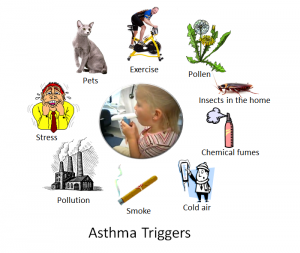Age-specific management of asthma in children
The medical definition of asthma is a chronic inflammatory disorder marked by spasms in the bronchi of the lungs, causing difficulty in breathing. It usually results can be triggered by breathing in substances called allergens or triggers (Mayo Clinic Staff). Common asthma triggers include:
• Animals (pet hair or dander)
• Dust mites
• Certain medicines (aspirin and other NSAIDS)
• Changes in weather (most often cold weather)
• Chemicals in the air or in food
• Exercise
• Mold
• Pollen
• Respiratory infections, such as the common cold
• Strong emotions (stress)
• Tobacco smoke (Mayo Clinic Staff)
The inflammation causes symptoms associated with obstructive airflow, wheezing, and irritated cough that is common. Asthma is caused by inflammation (swelling) in the airways. When an asthma attack occurs, the lining of the air passages swells and the muscles surrounding the airways become tight (Nowak RM). This reduces the amount of air that can pass through the airway resulting from bronchial smooth muscle spasm, or inflammation of the bronchial wall or excessive production of mucus. Asthma in children is often confused with acute middle and lower respiratory tract infections. Onset usually occurs between 3 and 8 years of age (Asperen).
 Post title...
Post title...
 Post title...
Post title...

 amberjm21
amberjm21